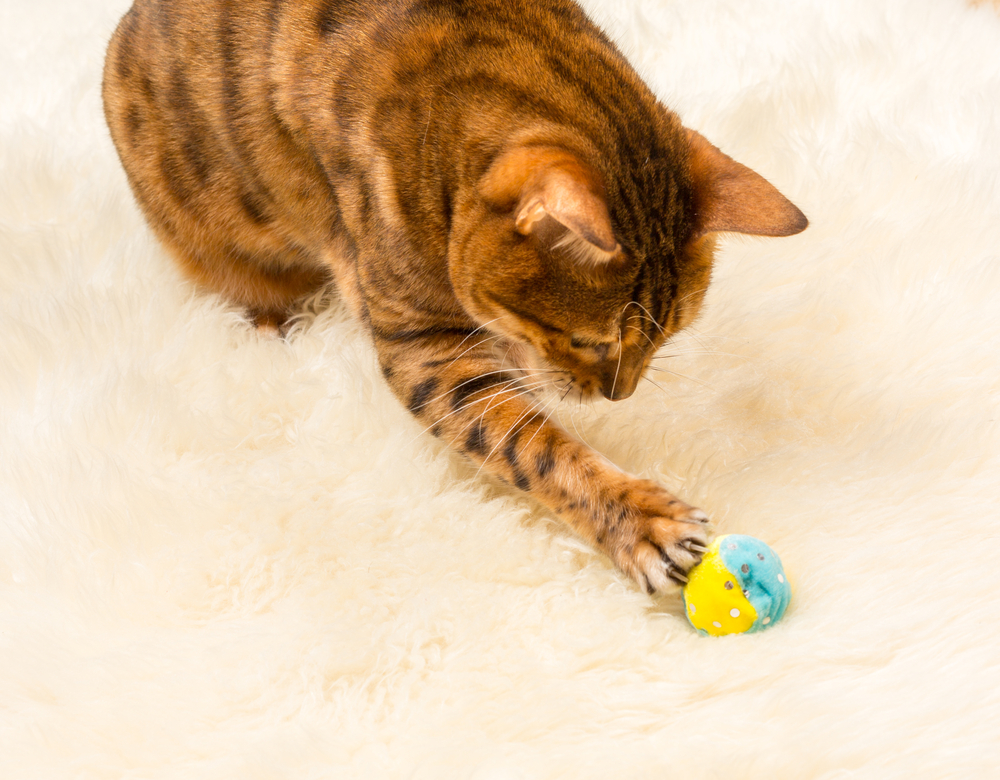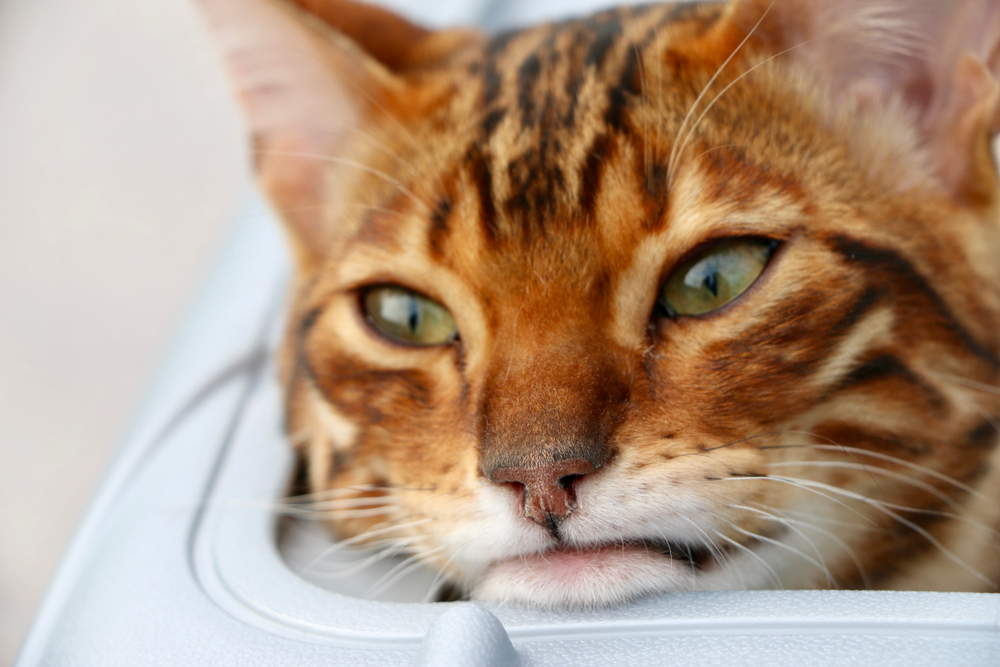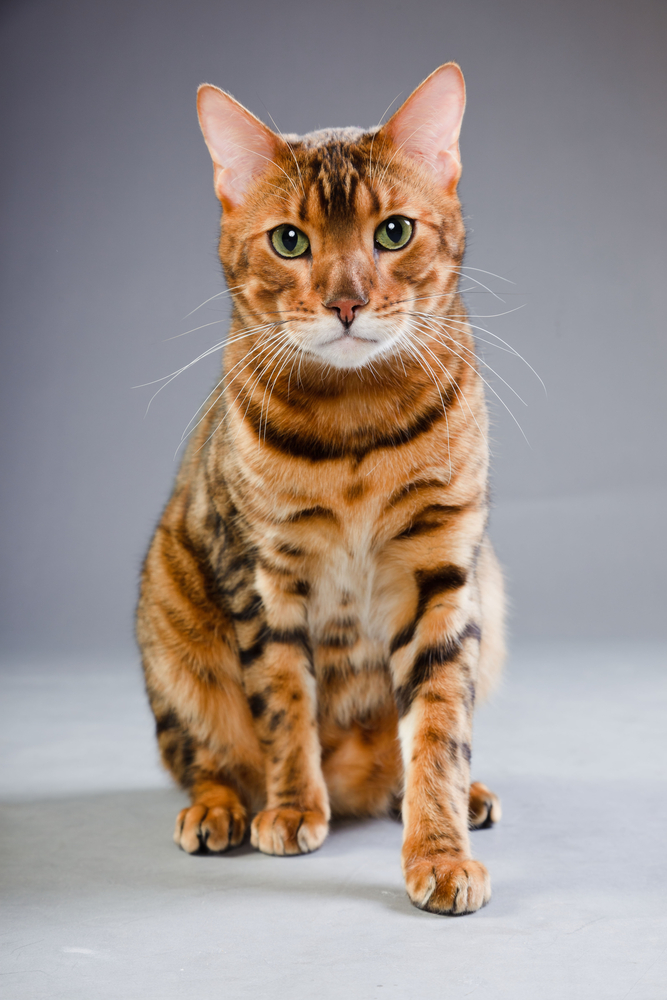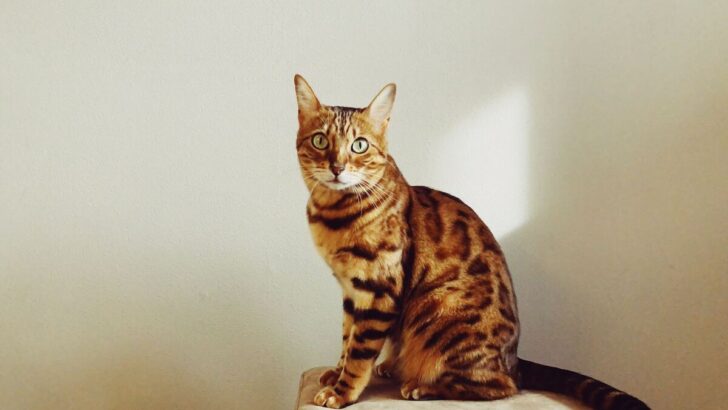“Are orange Bengal cats real?” you ask, and we deliver. Actually, orange Bengal cats are many things – they’re strikingly beautiful, breathtaking, and rare. They’re affectionate, appreciative, and aggressive at times. They’re physically active and friendly. They’re the purrfect pets when they’re taken care of.
And yes, they’re real. As a matter of fact, orange Bengal cats aren’t much different from average Bengal cats. They’re lighter than brown Bengals, and because of the different hues that a Bengal’s undercoat can assume, they’re often mistakenly referred to as orange Bengals.
At the end of the day, though, orange Bengals aren’t officially accepted by the Cat Fancier’s Association (CFA) or the International Cat Association (TICA), but brown Bengals are. But that doesn’t mean that you can’t obsess over the thought of getting an orange Bengal cat – it’s simply a matter of semantics!
Now, whether they’re brown, silver, snow, or blue, Bengals are one of the most mysterious breeds out there and we’re more than happy to offer you the scoop you need to figure out whether you’re fit to become a Bengal pet parent. What are you waiting for – get to reading!
Orange Bengal cats: myth or reality?

Orange Bengal cats aren’t a myth. These beautiful beasts aren’t accepted by any of the renowned cat associations, but they are a variant of one of the hues that have been accepted from the get-go. Brown or orange, Bengal cats are the closest to owning a wild cat you can ever get.
Bengal cats started as a combination of a domestic cat and an Asian leopard cat. Similarly to some of the other wild-looking breeds, such as Savannah cats, Bengal cats go through a rigorous process of classification to ensure they’re “domestic enough” for you to keep – an Asian leopard cat’s kittens, for example, are classified as F1.
So, Bengal cats need to reach an F4 (but an F5 or an F6 would be better) to be considered domestic. Because breeders don’t always follow the process of classification, Bengal cats are banned from certain locations, such as Hawaii or New York City.
But that shouldn’t tarnish the Bengal cat’s pure, pristine reputation. The Bengal is one of the most popular, prominent breeds around the world for a reason – these felines are super fun to have around, easy on the eye, and a conversation starter, for sure.
Now, there’s reason to believe that Bengal cats have a lengthy history, too. They appeared as early as the 1800s, but we didn’t get the Bengals we know and adore before the 1960s. Jean Mill, a breeder, conservationist, and cat connoisseur, started crossing domestic cats with Asian leopard cats around 1963.
Bengals were officially recognized by 1996, but the CFA required that the recognized Bengals need to be brown, silver, snow, or blue and that they need to be F6 or higher. Orange Bengal cats being considered a variant of brown Bengal cats pretty much means they’re accepted, but not fully.
What to know about orange Bengal cats before getting one

Maybe you have your heart set on getting a Bengal kitten that’ll make you feel like you’re living with a wild cat. Perhaps you want to check whether the “orange cat behavior” applies to orange Bengal cats, too (even though they’re technically brown).
Whatever your reasons might be, don’t shy away from doing your research before you hop over to the nearest breeder and get your hands on an orange Bengal kitty.
What are orange Bengal cats like? And what do they need to have a happy and healthy life?
Moreover, are you even allowed to own an orange Bengal cat where you live? People used to keep wild cats as pets before Bengal cats became a breed, but there are breeders that don’t follow the rules and regulations and endanger people by selling them Bengal kittens that haven’t reached the F4, F5, or F6 mark.
More on Bengal cats, orange or otherwise, down below!
1. What do orange Bengals look like?
We can’t talk about Bengal cats, especially not orange ones, without addressing the wild looks that come with owning one. Bengal cats are pretty much pocket leopards or ocelots that have been taught to use the litter box, tolerate humans, and act like the little divas that they are.
Generally speaking, Bengals are long and lean, growing up to 10 inches and 15 pounds.
With a short yet soft coat, almond-shaped eyes, and perked-up ears, they’re a sight for sore eyes. Whether they’re flaunting their rosette markings or staring at you with their warm brown, yellow, orange, or green eyes, they’re guaranteed to capture your full attention.
We touched upon the fact that the accepted Bengal cat colors are brown, silver, snow, and blue – but they can be spotted or marbled with different shades of these colors, too. Because of that, orange Bengal cats are more common than you’d assume.
Whether they’re lounging outside on a hot summer day or showing off a myriad of light brown rosettes, they’re more than likely to appear orange rather than brown.
2. What about their purrsonality – do they have the “orange cat behavior” everyone’s been making fun of online?

Orange Bengal cats are “cuckoo for cocoa puffs” like the array of orange cats you see on TikTok or Instagram. On one hand, they’re super affectionate and appreciative, and they’re attached to humans that take care of them much more than you’d expect them to be, considering they’re a little wild and all.
On the other, they’re known to wreak havoc wherever they go. From biting your hands and legs out of the blue and breaking your favorite perfume bottle while maintaining eye contact, to waking you up at 3 a.m. meowing at God knows what, they’re a handful.
Furthermore, they’re curious creatures, which means they’re more than likely to go through every nook and cranny of your apartment every time you go to work. But one thing’s for sure – they aren’t aggressive, no matter what the haters and naysayers claim.
3. What do orange Bengals need to have a happy and healthy life?
Bengal cats are attached to humans, and they pretty much need you to be there 24/7 for them to be happy and healthy. Before you say something along the lines of “I have to go to work!” – we know. But, we do suggest that you spend quality time with your Bengal whenever you get the chance.
Snuggling, watching Netflix, and hanging out can be a part of that, but Bengal cats need plenty of physical activity and mental stimulation, too.
Start by getting your little leopard a cat tree she can climb on when you’re away. Spoil her with plenty of toys she can play with. Consider arranging a seating area for her next to the widow. Bengals adore watching birds, squirrels, and the rest of the animal kingdom.
4. Grooming, bathing, pampering – are orange Bengals high maintenance?

Bengal cats, regardless of color, have short, soft coats, but that’s not to say that these gorgeous creatures don’t shed. Before you get an orange Bengal cat and expect her to wake up like Beyonce, “I woke up like this, I woke up like this…” you might need to think twice.
Now, they’re not as high maintenance as Ragdolls or Maine Coons, but you do need to brush them once or twice a week to keep them neat and clean. Bengals are keen on water, too, and you might want to bathe your Bengal cat every now and then. Brush her teeth, cut her nails, and you’re good to go.
5. What are an orange Bengal cat’s health concerns?
Bengal cats are naturally healthy, but there are a bunch of factors that determine whether or not your Bengal’s going to have a happy and healthy life.
With proper nutrition, plenty of physical activity, regular vet checkups, and affection, there’s no reason your Bengal cat can’t reach 15 years old (which is the average lifespan).
Getting your Bengal cat from a reputable breeder makes a huge difference, too. But, same as most cats, Bengal cats can experience certain health niggles down the road. Heart disease, eye disease, and anesthetic allergies are three common ones you might want to keep an eye on.
Should you consider getting an orange Bengal cat as a pet?

Orange Bengal cats are amazing, and we’re not surprised that you’re thinking of adding one to your family. Of course, you do need to weigh the pros and cons to ensure you’re making the right decision for yourself, your loved ones, and your furry friend-to-be.
We don’t even need to repeat ourselves, but we do want you to know that an orange Bengal cat can be the purrfect pet – depending on what you’re searching for. Bengal cats are hyperactive attention seekers, and they’re a lot to handle for people who prefer lap pets.
Because of that, we urge you to do your research before you go out and get one. That said, there’s nothing she can do that you wouldn’t forgive her the moment you see her warm eyes and hear her happy chirrups. Good luck!
